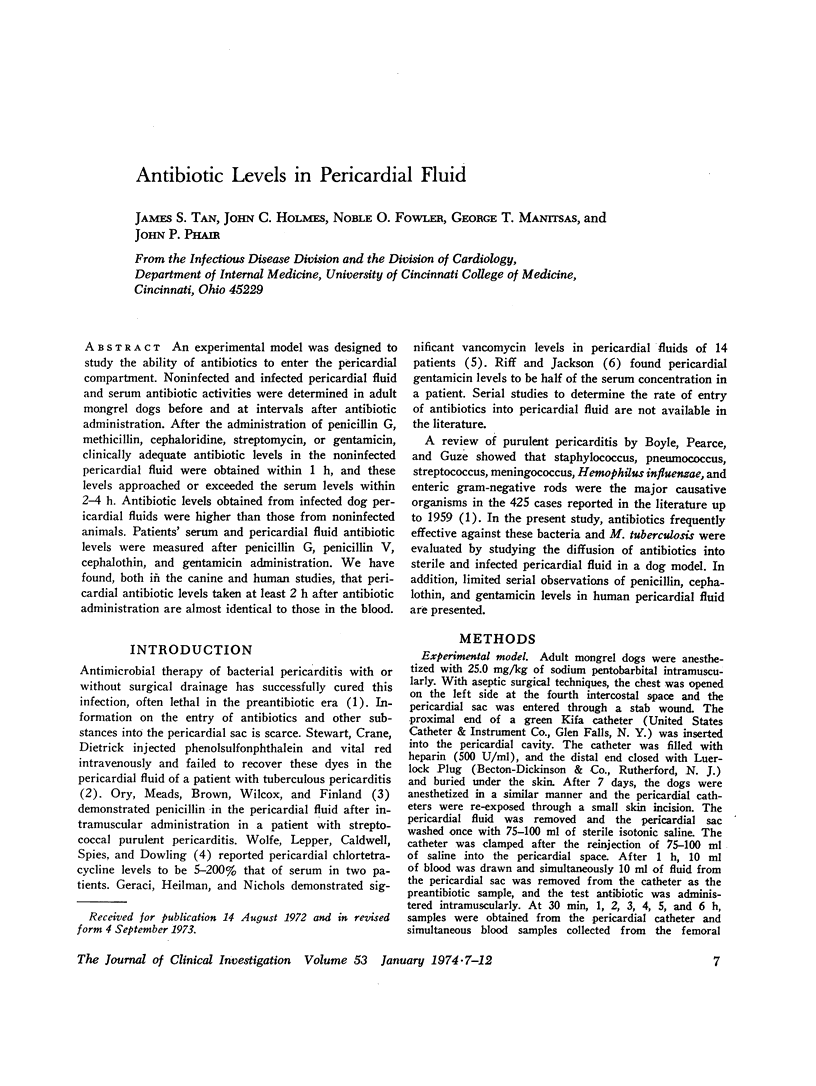Abstract
An experimental model was designed to study the ability of antibiotics to enter the pericardial compartment. Noninfected and infected pericardial fluid and serum antibiotic activities were determined in adult mongrel dogs before and at intervals after antibiotic administration. After the administration of penicillin G, methicillin, cephaloridine, streptomycin, or gentamicin, clinically adequate antibiotic levels in the noninfected pericardial fluid were obtained within 1 h, and these levels approached or exceeded the serum levels within 2-4 h. Antibiotic levels obtained from infected dog pericardial fluids were higher than those from noninfected animals. Patients' serum and pericardial fluid antibiotic levels were measured after penicillin G, penicillin V, cephalothin, and gentamicin administration. We have found, both in the canine and human studies, that pericardial antibiotic levels taken at least 2 h after antibiotic administration are almost identical to those in the blood.
Full text
PDF





Selected References
These references are in PubMed. This may not be the complete list of references from this article.
- Bennett J. V., Brodie J. L., Benner E. J., Kirby W. M. Simplified, accurate method for antibiotic assay of clinical specimens. Appl Microbiol. 1966 Mar;14(2):170–177. doi: 10.1128/am.14.2.170-177.1966. [DOI] [PMC free article] [PubMed] [Google Scholar]
- Gordon R. C., Regamey C., Kirby W. M. Serum protein binding of the aminoglycoside antibiotics. Antimicrob Agents Chemother. 1972 Sep;2(3):214–216. doi: 10.1128/aac.2.3.214. [DOI] [PMC free article] [PubMed] [Google Scholar]
- HENDERSON W. R., CARLETON J., HAMBURGER M. The effect of probenecid upon serum levels of methicillin. Am J Med Sci. 1962 Apr;243:489–495. doi: 10.1097/00000441-196204000-00010. [DOI] [PubMed] [Google Scholar]
- Kirby W. M., Standiford H. C. Gentamicin: in vitro studies. J Infect Dis. 1969 Apr-May;119(4):361–363. doi: 10.1093/infdis/119.4-5.361. [DOI] [PubMed] [Google Scholar]
- Riff L. J., Jackson G. G. Pharmacology of gentamicin in man. J Infect Dis. 1971 Dec;124 (Suppl):S98–105. doi: 10.1093/infdis/124.supplement_1.s98. [DOI] [PubMed] [Google Scholar]
- Rolinson G. N., Sutherland R. The binding of antibiotics to serum proteins. Br J Pharmacol Chemother. 1965 Dec;25(3):638–650. doi: 10.1111/j.1476-5381.1965.tb01788.x. [DOI] [PMC free article] [PubMed] [Google Scholar]
- Tan J. S., Trott A., Phair J. P., Watanakunakorn C. A method for measurement of antibiotics in human interstitial fluid. J Infect Dis. 1972 Nov;126(5):492–497. doi: 10.1093/infdis/126.5.492. [DOI] [PubMed] [Google Scholar]
- WOLFE C. K., Jr, LEPPER M. H., CALDWELL E. R., Jr, SPIES H. W., DOWLING H. F. Treatment of nontuberculous bacterial pleural space infections with aureomycin: results of treatment in nine patients; concentration of aureomycin in pleural and pericardial fluid in seven patients. Ann Intern Med. 1952 Jul;37(1):164–171. doi: 10.7326/0003-4819-37-1-164. [DOI] [PubMed] [Google Scholar]


